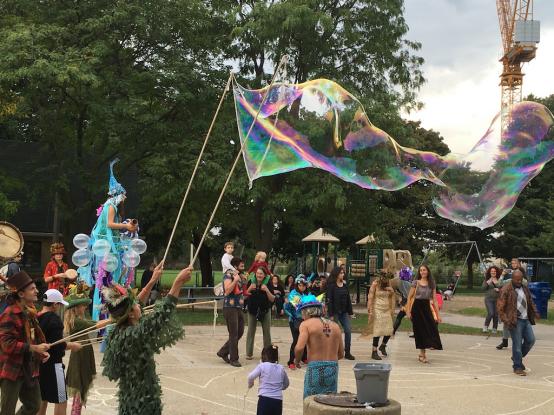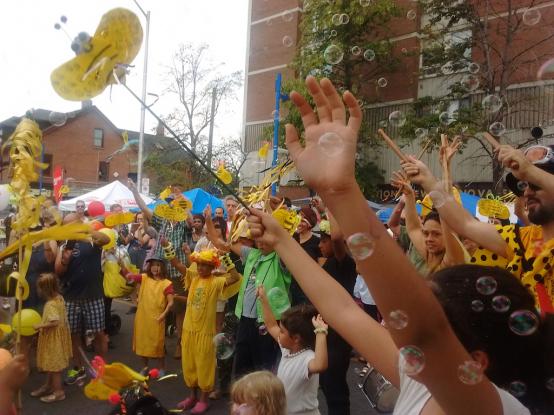The city is a structured place. Roads and sidewalks follow mainly straight lines, while houses, apartment buildings, offices and shops march dutifully alongside them, one after the other. Many of us live structured lives within our concrete, highly controlled world, following the schedules, routines, and norms of our workplaces and leisure activities. Urban green space is often no different -- processions of trees stand on manicured turf and garden beds are filled with neat lines of annuals. Community use of park space is defined and limited by a stifling array of municipal policies, bylaws, permits and red tape.
While this approach to governing public space is understandable in a city filled with as many competing interests as it has inhabitants, the wild and wayward life of a tiny, disproportionately lively square of parkland in Toronto's west end has a different lesson to teach us about the rewards of relinquishing control.
Growth of a park
MacGregor Playground is an unassuming neighbourhood park bordered by Lansdowne Avenue and the CN Railway line, sandwiched between a high school and dense residential area. Local lore remembers its past incarnations as a mere shortcut between Lansdowne and the smaller streets by day, and a dark, threatening place by night. Over the past several years, however, MacGregor Playground has begun to flourish under the tutelage of community members and a local arts group, now known as Botanicus Art Ensemble. The formerly non-descript park now features a Native Species garden, a bountiful Edible Teaching Garden, arts and garden programs for children and adults, and a series of seasonal nature-based community festivals.
The Native Species garden is a small but exceptionally diverse collection of wildflowers, grasses, and shrubs -- grey coneflower, little bluestem, and witch hazel. It is a microcosmic stage for the complex and cyclical dance of pollinators, pests, sun, rain, decay and rebirth. The Edible Teaching Garden is a whimsical oasis of curling little footpaths unfolding through oddly shaped, lush garden beds -- their curvatures echoing the spiralling, twisting tendrils and stems of companion-planted heirloom squash, tomatoes, beans and herbs. The gardens bring the wild back into the city -- a wildness that is impermanent yet timeless, cyclical yet unpredictable, governed by pattern yet uncontrolled and uncontrollable.

As stewards of the gardens, program participants temporarily transcend the domesticated cityscape and take part in something larger than the human. This "something" can be guided by our hand but is forever beyond our grasp. The Botanicus Art Ensemble artists invite everyone to be a little untamed, a little more free -- and so they have been, donning elaborate hats with towering ornaments that reach to the sky, and long sparkling robes that flow like water.
Throughout the growing season of 2016, Botanicus Art Ensemble led garden-side, nature-inspired arts programs in theatre, dance and music. Spring was celebrated with a large community gathering and a theatrical performance featuring original songs and characters such as "Snap Pea," a strutting, singing pea plant, and "The Centipedes," a dancing trio dispelling the stigma surrounding the creepy crawlies of the garden. July brought the "Bumble Bee Flash Mob," a sudden eruption of lively music and dance within the crowd at the BIG on Bloor Street Festival, performed by community members dressed as bees and butterflies to honour the importance of pollinators within the ecosystem we all depend on. In harvest season, the neighbourhood was brought together around food from the garden and a participatory drumming procession that circled the empty wading pool as if performing an ancient harvest ritual.
Taking art outside
"Working outside in a public park can be nerve-wracking," says Artistic Director Kristen Fahrig, "because you never know what the day will bring -- will there be a rainstorm? Who will turn up? But with professional artists and gardeners who can change on a dime, and enthusiastic volunteers and participants, you can be sure that what seems like a scary tight-rope walk into the unknown will become a joyful fanfare that trumpets a combined creative expression."

Between the celebrations were open drop-in workdays in the garden, spent learning and tending the garden, and volunteer days for neighbourhood high school students. People from all walks of life transformed the garden from a flat plot of land and a handful of seeds to an Eden of vegetables, fruits and herbs. A branch of the Toronto Seed Library was started, a city-wide initiative that promotes biodiversity, and putting seeds and seed knowledge into the hands of community members. As the months passed, participants formed unlikely and unusual friendships with neighbours whose paths they may not otherwise have crossed. They have stepped outside their shells. They have lingered outside in the park a little later.
The success of the arts and garden programs at MacGregor Playground sheds a new kind of light on the adage "if you love something then let it go." Most Torontonians can see there is much to love about parks and their potential to improve urban lives -- they give us a place to form a personal relationship with the environment, to be active and breathe clean air, to break down social isolation and build community.
Parks can be the life-giving counterbalance to wearying city life, but if MacGregor Playground tells us anything, it's that a blossoming life cannot be contained in the structured world we create for ourselves. It is messy and indefinable, it is cracks and spills and unexpected outcomes. It comes from the ground and it unfurls in myriad directions. If we want to reap all the benefits that Toronto parks have to offer, we must embrace the wildness of co-creating with nature, and with one another.
Ava Lightbody is a social and environmental justice activist and thinker, with a love for research, writing, the arts, and getting her hands dirty in the garden (or the kitchen!). She developed and led garden programs at MacGregor Playground in 2016 for the Botanicus Art Ensemble in collaboration with community members and Parks and Recreation staff. The column "Design for Democracy" focuses on sustainable design solutions for a greener future.
Botanicus Art Ensemble is a non-profit arts group -- actors, musicians, designers, gardeners and storytellers creating nature-inspired art with neighbours out of an urban park in Toronto, Canada. Their most recent park improvement project has been the creation of the MacGregor Teaching Gardens and in 2016, with funding from the Ontario Trillium Foundation the BAE commissioned a feasibility study of the MacGregor Fieldhouse from DTAH Architects to support year-round community programs. To read this study and find out more about BAE projects please visit www.botanicusart.com.
To join us in planting and caring for the MacGregor Teaching Gardens in the upcoming spring please contact info@botanicusart.com.
Photos by Kristen Fahrig.



Comments
Do
Don't